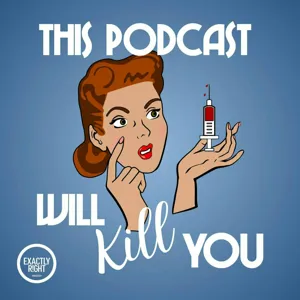Podcast Summary
Discovering Ancient Insights from Fossilized Feces: Fossilized feces, or coprolites, reveal details about extinct animals' diets, ecological relationships, and environmental conditions, deepening our understanding of Earth's history.
Coprolites, or fossilized feces, offer valuable insights into the past that extend beyond understanding parasite evolution and host relationships. These ancient packages of information can reveal details about extinct animals' diets, ecological relationships, and environmental conditions. Coprolites have been studied since the 1800s, but some of the most significant discoveries have been made in recent decades by Dr. Karen Chin, a leading expert in the field. Her research on Mesozoic ecosystems has provided invaluable knowledge about ancient environments and the organisms that inhabited them. The study of coprolites not only sheds light on the past but also highlights the importance of preserving and studying fossilized remains to deepen our understanding of Earth's history.
Insights into ancient diets and behaviors from coprolites: Coprolites, or fossilized feces, provide valuable information about ancient diets and behaviors through their unique contents, offering a different perspective compared to body fossils.
Coprolites, or fossilized feces, provide valuable insights into ancient diets and behaviors of organisms, offering a different perspective compared to body fossils. These trace fossils can vary greatly in shape and size depending on the animal and its diet, and they can be preserved through different means depending on their age. Coprolites are just one example of trace fossils, which also include footprints, burrows, and tooth marks, among others. While body fossils give us an idea of what an organism looked like, trace fossils tell us about their behaviors and activities, enriching our understanding of ancient life. Despite being a common occurrence, the contents of coprolites can offer unique and valuable information, capturing a snapshot of an animal's diet at a specific point in time.
Factors affecting coprolite preservation: Carnivore coprolites are more likely to be preserved due to their phosphorus-rich diet, while herbivore coprolites are rare. Environmental conditions at the time of deposition, such as rapid burial, can enhance preservation and even facilitate mineralization. Bacteria can contribute to the mineralization process.
The formation and preservation of coprolites, or fossilized feces, depend on various factors such as the animal's diet and environmental conditions. Carnivores are more likely to have their feces preserved due to the presence of phosphorus in their diet, while herbivore coprolites are rare because they require external sources of elements for mineralization. The environmental conditions at the time of deposition also play a crucial role in preservation, as rapid burial can slow bacterial decomposition and even facilitate mineralization. It may seem counterintuitive, but bacteria can contribute to the mineralization process by altering the microenvironment or producing certain substances. Understanding these factors can help scientists learn more about ancient diets and environments.
Microbes in ancient fecal matter reveal insights into diets and ecosystems: Microbes in coprolites help researchers learn about ancient animal diets and the recycling processes in ancient ecosystems
Microbes, particularly bacteria, play a significant role in the formation of chemical minerals in various environments, including those associated with animal feces. This is important because coprolites, or ancient fecal matter, can provide valuable insights into the diets and environments of extinct animals. By studying the preserved remains of bacteria and other organisms found in coprolites, researchers can learn not only what an animal ate but also how waste materials were recycled in ancient ecosystems. For instance, some bacteria facilitate the precipitation of minerals like calcium carbonate, while others, like snails, feed on dung after it's deposited. This multifaceted approach to analyzing coprolites expands our understanding of ancient environments and the complex interactions between organisms and their ecosystems.
Unexpected discoveries in dinosaur coprolites: Dinosaur coprolites can reveal insights into dinosaur diet and digestion, with recent findings suggesting short gut residence times and rapid mineralization of muscle tissue.
Coprolites, or fossilized feces, can provide valuable insights into various aspects of dinosaur life, including their diet and digestive system. A notable discovery was made when researchers found mineralized muscle tissue in a tyrannosaur coprolite, defying expectations that such tissue could survive the digestive process. This finding suggested that the dinosaur's gut residence time for food was relatively short, allowing undigested food to pass through and be preserved. Additionally, the rapid mineralization of muscle tissue in dead animals supports this hypothesis. This unexpected discovery not only shed light on the dinosaur's digestive system but also offered a unique perspective on the fossil record. Studying coprolites involves carefully examining thin sections under a microscope to identify potential tissues or structures. This serendipitous discovery underscores the importance of collaboration and seeking the expertise of colleagues in various fields.
Studying coprolites: Combining destructive and non-destructive methods: Paleontologists use various methods like thin sectioning, CT, X-ray CT, neutron CT, and synchrotron radiation to study coprolites. By combining age of sediments, size, and contents, they can identify the animal that produced it.
Paleontologists use various methods to study coprolites, including thin sectioning, which is destructive, and non-destructive techniques like computed tomography (CT), X-ray CT, neutron CT, and synchrotron radiation. Each method has its advantages and disadvantages, and researchers combine different techniques to learn as much as possible from coprolites. The age of sediments and the size and contents of the coprolite are crucial pieces of evidence to help identify the animal that produced it. By combining multiple lines of evidence, such as the age of sediments, size, and contents, researchers can narrow down the possibilities and make educated guesses about the animal's identity. For instance, a large coprolite with bone fragments is likely to have come from a large carnivore, such as a T. Rex. This interdisciplinary approach allows scientists to deduce valuable information from coprolites, which can significantly contribute to our understanding of ancient ecosystems and the animals that inhabited them.
Understanding ancient diets through coprolites: Coprolites, or fossilized feces, provide insights into the diets and behaviors of extinct animals, but their identification can be uncertain. They can reveal information about the presence of specific organisms in ancient ecosystems and even suggest dietary habits.
Coprolites, or fossilized feces, can provide valuable insights into the diets and behaviors of extinct animals, but their identification can be uncertain. For instance, researchers were confident that a large coprolite discovered was likely produced by a T. Rex, but it's possible that another large animal passed through the area and left the coprolite instead. Additionally, researchers have found coprolites from duck-billed dinosaurs that contained distinctive burrows, which were identified as dung beetle burrows by an expert. These findings not only shed light on the diet of the duck-billed dinosaurs but also revealed the presence of dung beetles and other recyclers in the ancient ecosystem. Another interesting discovery was the presence of conifer wood in the coprolites, which initially suggested that the dinosaurs were feeding on wood, but further study revealed that the wood fragments did not correspond to the branches of cone-bearing trees. Overall, coprolites offer a unique window into the past, allowing researchers to learn about the diets and ecological roles of extinct animals.
Dinosaur coprolites reveal unexpected dietary habits: Dinosaur coprolites, or fossilized poop, contain cellular structures from white rot fungus, indicating that dinosaurs consumed rotten wood for protein during nesting and egg-laying. This challenges assumptions about dinosaur diets and highlights the value of coprolites as sources of information about ancient life.
The discovery of dinosaur coprolites, or fossilized poop, has provided scientists with valuable insights into the diets and behaviors of these extinct animals. The presence of cellular structures in the coprolites, which can only be produced by white rot fungus, indicates that dinosaurs consumed rotten wood as a source of protein, particularly when nesting and laying eggs. This discovery challenges the common assumption that dinosaurs were strictly herbivorous or omnivorous, and highlights the importance of coprolites as a source of information about ancient life. Additionally, the presence of other fossils, such as termites, crustaceans, and snails, found in the same coprolites, further supports this hypothesis. Overall, the study of coprolites offers a unique perspective on dinosaur behavior and diet, and underscores the importance of continuing research in this area.
Exploring the Surprising World of Coprolites: The study of coprolites, or fossilized feces, offers valuable insights into dinosaur interactions and ancient ecosystems, despite the challenges of identifying and studying the material.
Studying paleontology, specifically coprolites or fossilized feces, has been a surprising and thrilling experience for the speaker. She initially found the idea frustrating, but discovered that she had an affinity for the subject. The study of coprolites provides valuable insights into dinosaur interactions with other organisms in their environment. Over the course of her career, she has seen advancements in technology and methods used to study coprolites, making it an exciting time for trace fossils. Despite the challenges, such as identifying and studying the material, the rewards are significant, offering unique insights into the past. People all over the world are now studying coprolites using various techniques, expanding our knowledge of ancient ecosystems.
Connecting with the public: A crucial role for paleontologists: Paleontologists play a vital role in sharing their research with the public, debunking misconceptions, and inspiring future generations.
Scientists, including paleontologists, have a crucial role in connecting with the public and sharing their research. By doing so, they help make science more approachable and better understood by everyone. Misconceptions about paleontology and paleontologists, such as the belief that they are the same as archaeologists or that they spend all their time in the field, are common but not harmful. Graduate students in paleontology are increasingly recognizing the importance of communicating their science to the general public, and there is a growing trend towards providing training in this area. As for favorite puns, the speaker shared an old one about COBRA lights being challenging to study, which may not be appreciated by all but highlights the sense of humor often found in the scientific community.
The Study of Coprolites: Unraveling the Mysteries of Fossilized Feces: Coprolites, or fossilized feces, reveal clues about ancient diets and the identities of their producers, but their analysis is complex and often mysterious.
The study of coprolites, or fossilized feces, is an intriguing and complex field of science. As Dr. Chin explained, the identity of the producer and the specific details of what was consumed can often remain a mystery. This adds to the challenge and excitement of this research area. If you're intrigued by coprolites and want to learn more, be sure to check out the resources we've linked on our website, including papers by Dr. Chin. Don't forget to subscribe to our podcast, and for early access and ad-free listening, consider subscribing to Wondery Plus. Stay tuned for our next episode on a new topic, and in the meantime, keep exploring the fascinating world of coprolites!










